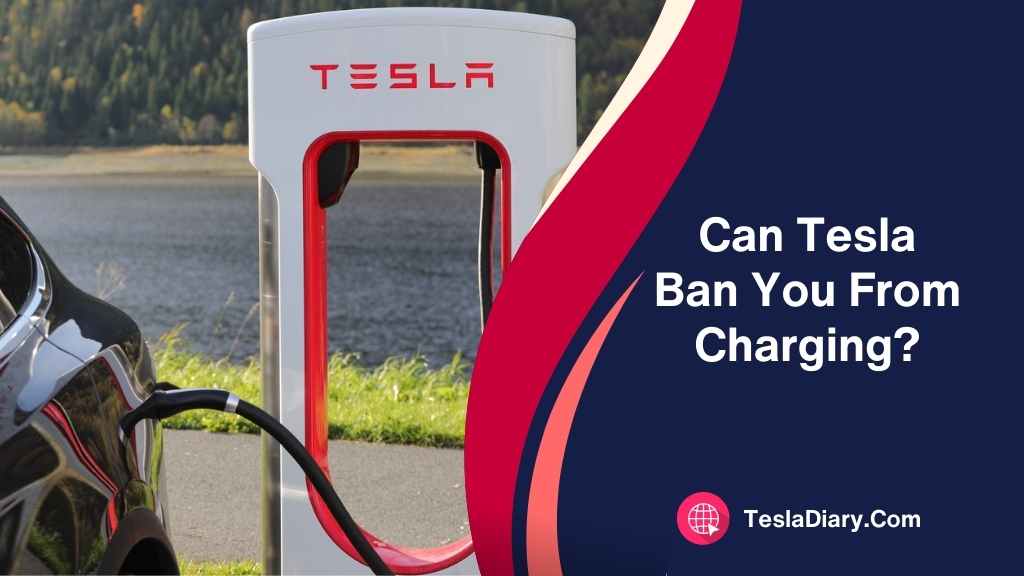Tesla has established an extensive Supercharger network to cater to its users’ needs, ensuring quick and convenient charging options.
However, a significant controversy surrounds Tesla’s ability to ban users from charging at its Supercharger stations.
In this article, we will delve into this controversy in detail. Stay with us.
Can Tesla Ban You From Charging?
Tesla can not ban you from charging. However, they can block your access to Tesla’s superchargers for violating their rules. While there are not many cases of this happening, we have heard of people getting restricted from using superchargers.

Reasons for Potential Bans from Supercharger
Tesla has implemented a comprehensive set of rules and guidelines to govern the use of its Supercharger network, aimed at ensuring a seamless and equitable charging experience for all users. Violating these policies can lead to users being banned from accessing the Supercharger network. Let’s explore these common reasons for potential bans in greater detail:
1. Violation of Tesla’s Supercharger Usage Policy
Tesla has established a set of rules under its Supercharger Usage Policy to maintain order and fairness at charging stations. These policies are designed to encourage responsible and considerate use of the Superchargers. Common violations include:
– Loitering at Charging Stations
Superchargers are specifically designed for efficient, high-speed charging, intended to minimize wait times for users.
Tesla prohibits users from using Superchargers as long-term parking spots after their vehicles have finished charging.
This restriction helps ensure that charging stations remain available for other users who need to charge their vehicles promptly.
However, if you remain at the charging station after the car is fully charged, Tesla will charge you an idle fee. While I heard about restricted access for this reason before, could not find a person getting blocked from charging for this recently.
– Leaving Vehicles Unattended
To ensure a smooth flow of charging and prevent unnecessary delays, Tesla expects owners to stay with their vehicles during the charging process.
Leaving a vehicle unattended at a Supercharger disrupts the efficiency of the network and can lead to access restrictions for users who fail to comply with this rule.
2. Potential Misuse or Abuse of Superchargers
Tesla’s Superchargers are strategically located along major travel routes, primarily intended to support long-distance travel.
However, some users have been found to misuse Superchargers for various purposes. This misuse can strain the Supercharger network and inconvenience other users.
Tesla addresses this issue by issuing warnings and, in severe cases, imposing bans on users who repeatedly misuse Superchargers for non-long-distance charging needs.
3. Using Supercharging Facilities for Parking Purposes
Tesla has a clear policy against using Superchargers as parking spaces without the intention to charge the vehicle.
This practice not only disrupts the availability of Superchargers for users genuinely in need of charging but also goes against the intended purpose of these stations as charging hubs. Users engaging in this behavior may face access restrictions.
4. Charging Too Quickly, Causing Issues
Tesla’s Superchargers are engineered to deliver rapid charging to electric vehicles. However, excessively rapid charging, especially on a frequent basis, can have adverse effects on the vehicle’s battery.
Sometimes, the charging station can also get overwhelmed by continuous high-intensity charging. This can lead to undue wear and tear, higher maintenance costs, and potential safety concerns.
To prevent these issues, Tesla monitors charging behavior and may impose consequences, such as access restrictions to specific Tier of quick charging for a brief period. This is not a literal ban, rather a safety mechanism to keep your vehicle and the charging station safe from hazard.
5. Non-Payment of Supercharging Fees
Tesla Supercharger users are expected to pay for the electricity they consume during their charging sessions.
Failure to make these payments is not only a breach of Tesla’s terms of service but also unfair to other users who do pay for their electricity.
Tesla enforces this policy to maintain the integrity of the Supercharger network and may restrict access to those who do not adhere to the fee payment requirements.
Among all the reasons, this is the reason accounted for almost 95% of the supercharger access restriction cases.
Conclusion
The question of whether Tesla can ban users from charging at its Supercharger stations is a complex and contentious issue.
While Tesla’s control over its charging network is intended to ensure a positive experience for its users, it also raises important questions about user rights and fairness.
As electric vehicles continue to grow in popularity, the balance between control and access to charging infrastructure remains a significant concern for both Tesla and the broader EV community.
The outcome of this debate will likely shape the future of electric vehicle charging infrastructure and regulations.

